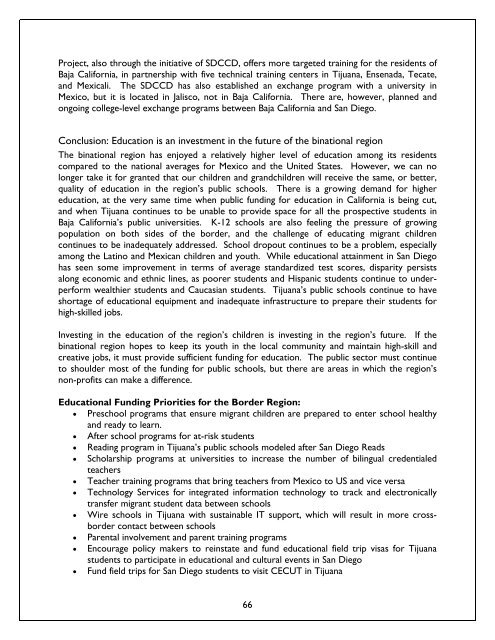Blurred Borders - International Community Foundation
Blurred Borders - International Community Foundation
Blurred Borders - International Community Foundation
Create successful ePaper yourself
Turn your PDF publications into a flip-book with our unique Google optimized e-Paper software.
Project, also through the initiative of SDCCD, offers more targeted training for the residents of<br />
Baja California, in partnership with five technical training centers in Tijuana, Ensenada, Tecate,<br />
and Mexicali. The SDCCD has also established an exchange program with a university in<br />
Mexico, but it is located in Jalisco, not in Baja California. There are, however, planned and<br />
ongoing college-level exchange programs between Baja California and San Diego.<br />
Conclusion: Education is an investment in the future of the binational region<br />
The binational region has enjoyed a relatively higher level of education among its residents<br />
compared to the national averages for Mexico and the United States. However, we can no<br />
longer take it for granted that our children and grandchildren will receive the same, or better,<br />
quality of education in the region’s public schools. There is a growing demand for higher<br />
education, at the very same time when public funding for education in California is being cut,<br />
and when Tijuana continues to be unable to provide space for all the prospective students in<br />
Baja California’s public universities. K-12 schools are also feeling the pressure of growing<br />
population on both sides of the border, and the challenge of educating migrant children<br />
continues to be inadequately addressed. School dropout continues to be a problem, especially<br />
among the Latino and Mexican children and youth. While educational attainment in San Diego<br />
has seen some improvement in terms of average standardized test scores, disparity persists<br />
along economic and ethnic lines, as poorer students and Hispanic students continue to underperform<br />
wealthier students and Caucasian students. Tijuana’s public schools continue to have<br />
shortage of educational equipment and inadequate infrastructure to prepare their students for<br />
high-skilled jobs.<br />
Investing in the education of the region’s children is investing in the region’s future. If the<br />
binational region hopes to keep its youth in the local community and maintain high-skill and<br />
creative jobs, it must provide sufficient funding for education. The public sector must continue<br />
to shoulder most of the funding for public schools, but there are areas in which the region’s<br />
non-profits can make a difference.<br />
Educational Funding Priorities for the Border Region:<br />
• Preschool programs that ensure migrant children are prepared to enter school healthy<br />
and ready to learn.<br />
• After school programs for at-risk students<br />
• Reading program in Tijuana’s public schools modeled after San Diego Reads<br />
• Scholarship programs at universities to increase the number of bilingual credentialed<br />
teachers<br />
• Teacher training programs that bring teachers from Mexico to US and vice versa<br />
• Technology Services for integrated information technology to track and electronically<br />
transfer migrant student data between schools<br />
• Wire schools in Tijuana with sustainable IT support, which will result in more crossborder<br />
contact between schools<br />
• Parental involvement and parent training programs<br />
• Encourage policy makers to reinstate and fund educational field trip visas for Tijuana<br />
students to participate in educational and cultural events in San Diego<br />
• Fund field trips for San Diego students to visit CECUT in Tijuana<br />
66















